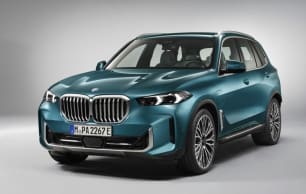The E-Pace’s bonnet, front guards, roof, tailgate and key suspension components may be made of weight-saving alloy, but this chunky little SUV still tips the scales at a sturdy 1832kg. Nonetheless, Jaguar claims the Chequered Flag P250 will accelerate from 0-100km/h in 7.1sec, which is quick, if not blindingly so.
The 2.0-litre twin-scroll turbo-petrol engine delivers a solid block of (peak) torque (365Nm) from just 1300rpm all the way to 4500rpm, which combined with no less than nine auto gear ratios means healthy mid-range punch is always available.
The transmission’s adaptive shift system reads the way you’re driving to tailor its behaviour accordingly, and it works well. But shifting gears manually via the wheel-mounted paddles adds to the fun and accuracy.
Thing is, despite being finished in racy black, the paddles themselves are plastic which feels ordinary and is a letdown in an otherwise high-end environment.
Suspension is strut front, ‘integral’ multi-link rear, and ride quality is surprisingly cushy for a high-riding car of this size. No tricky active dampers here, just a well-engineered set-up tuned to cope with a variety of conditions.
That said, the ‘JaguarDrive Control’ system offers four modes - ‘Normal’, ‘Dynamic’, ‘Eco’ and ‘Rain/Ice/Snow’ - tweaking things like the steering, throttle response, transmission shifts, stability control, torque vectoring, and AWD system.
Dynamic is the sweet spot, buttoning everything down just a little tighter, without any major effect on refinement, the car remaining quiet and composed even when driver enthusiasm starts to take the upper hand.
The variable ratio ‘Speed proportional’ electrically-assisted steering is nicely weighted and points nicely, but road feel is mediocre. On the flip side, the torque vectoring system, which uses the brakes to put the squeeze on a wheel breaking traction in cornering, works seamlessly.
Brakes are 349mm vented discs at the front and 300mm solid rotors at the rear, and although they arrest the car well enough, initial pedal feel is ‘grabby’, especially at slow speeds. It’s a challenge to grease your pedal application to the point where the effect goes away.
Under the heading of General Notes, the ergonomic layout is hard to fault with super clear instruments and user-friendly switchgear, but the ‘Ebony’ headlining darkens the interior too much. Even though the huge (standard) glass sunroof lets in a lot of light, we’d prefer the lighter ‘Ebony’ shade available on other E-Pace grades (but not this one).
Speaking of the interior, the sports front seats are grippy yet comfortable on longer runs, and their (standard) heating is a big plus on chilly mornings, the (21:9) wide format hi-res media screen is a pleasure to use, and the level of quality and attention to detail all around the cabin is impressive.


































